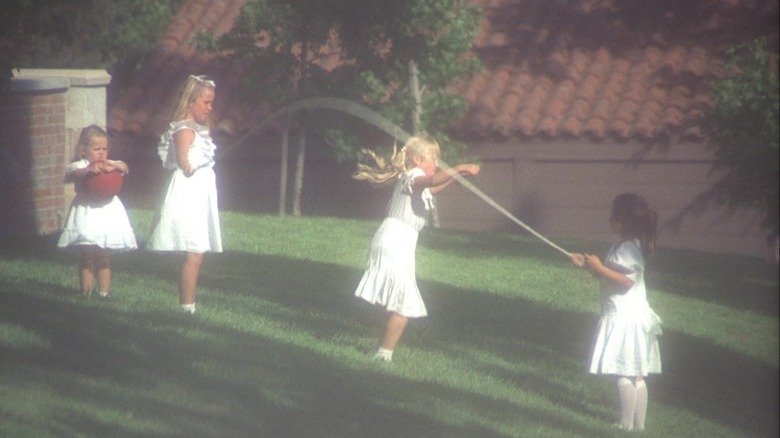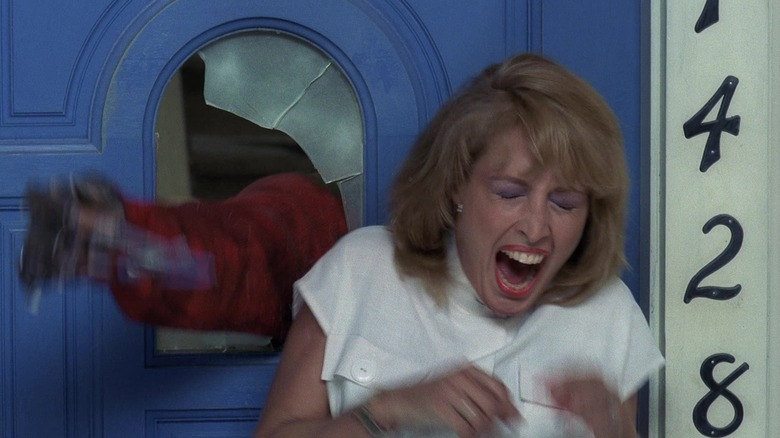The American National Tragedy That Gave A Nightmare On Elm Street Its Name
40 years later, the original "A Nightmare on Elm Street" has more than earned its place in cinema history as a slasher classic. Written and directed by the late (and very much missed) Wes Craven, the 1984 horror film follows a group of teens from Springwood, Ohio — which looks suspiciously like Los Angeles in several shots, but charmingly so — as they begin dreaming of the same mysterious figure. This man, whose face is covered in burn marks and wears a glove armed with razor blades, is no shared figment of their imagination. He's Freddy Krueger (Robert Englund), the vengeful ghost of a local child murderer who now has the power to kill his victims in their sleep.
Why is he vengeful? Freddy, you see, was eventually arrested but avoided punishment after getting off on a legal technicality. In retaliation, his victims' loved ones hunted him down and burnt him to death, and now he's back to punish their children. (That and because, you know, he's a horrible, horrible person who loves killing people.) "A Nightmare on Elm Street" is a great horror story about kids paying for the sins of their parents, but it's also about the failures of the U.S. criminal justice system. In a larger sense, it serves as a parable about the dark truth of American history, how our institutions frequently fail the most vulnerable members of society, and how younger generations keep having to battle the same monsters (literal monsters, in Freddy's case) that were supposedly defeated long ago. It's only fitting, then, that Craven got the film's title from one of the most infamous American national tragedies in the 20th century.
John F. Kennedy was assassinated on Elm Street
In author Wayne Byrne's 2022 book "Welcome to Elm Street: Inside the Film and Television Nightmares," Englund notes that "Elm Street" has "many" connotations. It is, for example, the setting of William S. Gray's wholesome Dick and Jane books for kids, which represent "the ideal family existence, much like what the people of Springwood aspire to," Englund muses. It's also, he adds, the place in Dallas, Texas where U.S. President John F. Kennedy was shot and killed in 1963, which represents the darkness symbolized by Freddy.
For members of Englund and Craven's generation, JFK's assassination marked the beginning of the end of the optimism that characterized the counter-cultural movements and revolution of the mid-20th century. To them it was "the last moment of American optimism, it was the loss of American innocence, it was our loss of trust and the beginning of our incredible cynicism," as Englund puts it. Between the subsequent murders of influential activists like Martin Luther King Jr. and Harvey Milk, the drawn-out bloody conclusion of the Vietnam War, the resurgence of the domestic terrorists that are the Ku Klux Klan, and the rise of modern conservatism with the election of Ronald Reagan, Craven had plenty of real-world inspiration to mine for the horror film that revived his then-flailing career. "And so the Nightmare on Elm Street is really the Nightmare of America," Englund reasons.
40 years later, the message of "A Nightmare on Elm Street" applies just as much to our current hellscape as the one that Craven lived through. It's a horror film about the importance of resisting evil as personified by Freddy Krueger. The movie's teens might not be able to truly win that battle — as the film's surreal final moments suggest — but that doesn't mean they're wrong to fight back anyway.

